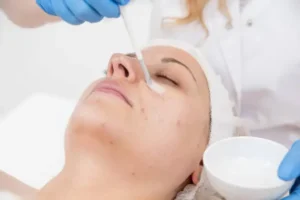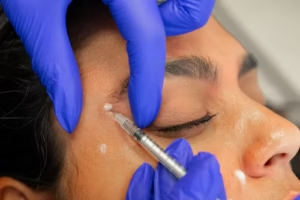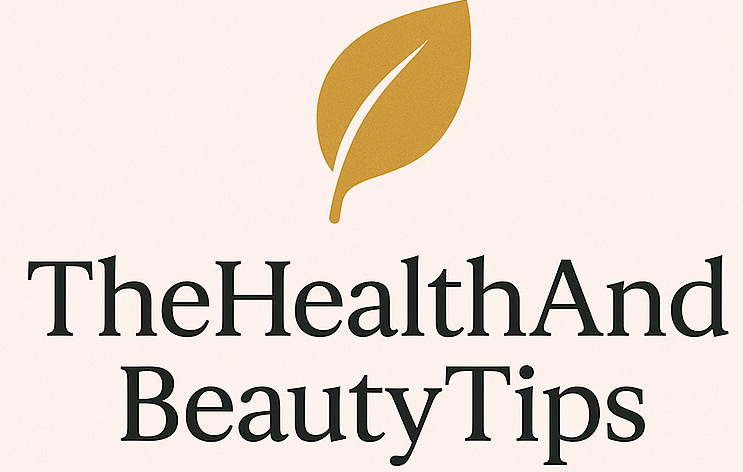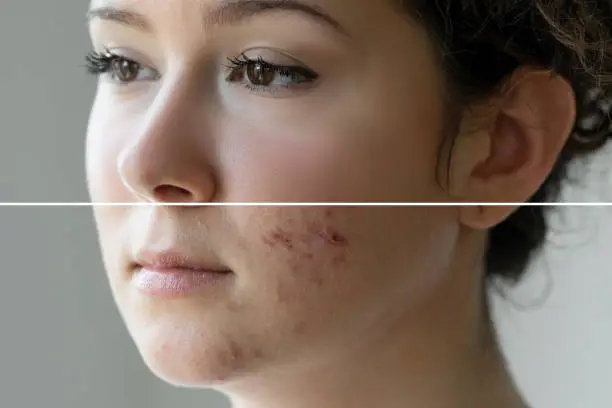Pimple scar removal treatment
Pimples, breakouts, and acne are common skin concerns, especially among teenagers and young adults. While pimples may eventually heal, they often leave behind unsightly scars that can persist long after the acne has cleared up. If you’re struggling with pimple scars and looking for ways to remove or reduce their appearance, you’re not alone.
will walk you through the best treatments for pimple scar removal, whether you’re dealing with hyperpigmentation, deep scars, or post-acne redness. From home remedies to advanced skincare treatments, we’ll cover it all so you can achieve smoother, clearer skin.
Understanding Pimple Scars
Before we dive into scar removal treatments, it’s important to understand the types of pimple scars that can form, as this will guide the appropriate treatment options. Pimple scar removal treatment
Types of Pimple Scars
Ice Pick Scars:
- Ice pick scars are deep, narrow scars that appear like tiny pits or holes on the skin’s surface. These are usually caused by cystic acne and are one of the most challenging scars to treat.
Boxcar Scars:
- Boxcar scars are broad, shallow scars with defined edges, resembling an indent in the skin. These types of scars can be caused by severe acne that has affected the skin’s collagen production.
Rolling Scars:
- Rolling scars have a wave-like, uneven appearance, giving the skin a rolling effect. These scars are typically the result of collagen loss in the deeper layers of the skin, making the surface uneven.
Hypertrophic Scars:
- Unlike the scars mentioned above, hypertrophic scars are raised scars that form when the skin overproduces collagen during healing. These are more common with deep, inflamed pimples and are typically red or pink.
Post-inflammatory Hyperpigmentation (PIH):
- Post-inflammatory hyperpigmentation refers to dark spots left on the skin after acne has healed. These spots are caused by an excess production of melanin in response to inflammation and can take weeks or months to fade.
Factors That Affect Scar Healing
Several factors can impact how your pimple scars heal, including:
- Skin Type: Individuals with darker skin tones may be more prone to hyperpigmentation, while those with lighter skin may be more prone to scarring.
- Severity of Acne: The more severe the acne, the higher the likelihood of developing noticeable scars.
- Treatment Methods: How you treat your acne and scars plays a significant role in the healing process.
- Genetics: Some people may be more genetically predisposed to scarring or poor wound healing.
Understanding these factors can help you choose the right treatment options and set realistic expectations for scar removal.
Best Pimple Scar Removal Treatments
There are numerous treatments available to help fade and remove pimple scars. Whether you’re looking for at-home remedies or professional treatments, we’ll cover both.
Topical Treatments
Topical treatments are one of the most common methods for treating pimple scars. These treatments involve applying products directly to the skin to fade scars and improve skin texture. Below are some of the most effective topical treatments:
a. Retinoids
- What They Are: Retinoids, such as retinol, tretinoin, and adapalene, are derivatives of vitamin A that accelerate skin cell turnover, reduce hyperpigmentation, and boost collagen production. They are commonly used to treat acne and can be helpful in fading scars over time.
- How They Work: Retinoids promote the shedding of dead skin cells, revealing fresh skin beneath. This helps to smooth out uneven skin texture and lighten dark spots.
- How to Use: Apply a small amount of retinoid cream or serum to your skin at night, as retinoids can increase sun sensitivity. Be sure to use sunscreen during the day.
b. Vitamin C
- What It Is: Vitamin C is a powerful antioxidant that can lighten dark spots and improve skin texture by reducing the appearance of post-inflammatory hyperpigmentation (PIH).
- How It Works: Vitamin C inhibits melanin production, which helps to fade dark spots caused by pimples and even out skin tone.
- How to Use: Look for serums or creams containing stabilized vitamin C and apply them to your face daily, preferably in the morning after cleansing. Pimple scar removal treatment
c. Alpha Hydroxy Acids (AHAs) and Beta Hydroxy Acids (BHAs)
- What They Are: AHAs, such as glycolic acid, and BHAs, such as salicylic acid, are exfoliating acids that help to slough off dead skin cells and encourage new skin growth.
- How They Work: These acids exfoliate the top layer of your skin, promoting faster cell turnover and preventing clogged pores. They can also help to reduce the appearance of scars by encouraging collagen production.
- How to Use: Apply AHA or BHA-based serums or toners to your face a few times a week, but be cautious if you have sensitive skin.
d. Niacinamide
- What It Is: Niacinamide, also known as vitamin B3, is a multitasking ingredient that has been shown to reduce inflammation, regulate oil production, and lighten dark spots.
- How It Works: Niacinamide helps reduce redness and pigmentation caused by acne, making it effective for treating both active breakouts and the scars they leave behind.
- How to Use: Niacinamide can be found in serums and creams, and it can be used twice daily to help brighten and even out your skin tone.
e. Hyaluronic Acid
- What It Is: Hyaluronic acid is a natural substance that draws moisture into the skin and keeps it hydrated.
- How It Works: While hyaluronic acid doesn’t directly target scars, it helps improve the overall texture of your skin, making scars appear less noticeable over time.
- How to Use: Apply a hyaluronic acid serum after cleansing to hydrate your skin and encourage healthy skin regeneration.
Chemical Peels

Chemical peels involve the application of an acidic solution to exfoliate the skin, removing the outer layers and revealing smoother, fresher skin beneath. There are three types of chemical peels:
- Superficial Peels: These peels only target the topmost layer of skin and are great for treating mild discoloration or hyperpigmentation.
- Medium Peels: Medium peels go deeper into the skin and can treat more severe acne scars and skin texture issues.
- Deep Peels: Deep peels are the most intense and are often used to treat deep scars and signs of aging.
Chemical peels can help reduce hyperpigmentation, smooth out uneven skin texture, and improve the appearance of acne scars over time.
Microneedling
Microneedling, also known as collagen induction therapy, involves the use of tiny needles to create controlled micro-injuries in the skin. This stimulates the body’s natural healing process and promotes collagen production, which can help improve the texture and appearance of scars.
- How It Works: The tiny punctures created by the microneedling device encourage your skin to regenerate, resulting in smoother skin and reduced scar appearance.
- Treatment Frequency: Microneedling can be done once a month for several sessions to see optimal results.
Laser Treatments
Laser treatments are often considered one of the most effective options for pimple scar removal. Different types of laser treatments target different types of scars:
a. Fractional CO2 Laser
- How It Works: The fractional CO2 laser targets both the surface and deeper layers of the skin to break down scar tissue and promote collagen production.
- Best For: Deep scars such as ice pick scars and boxcar scars.
b. Erbium YAG Laser
- How It Works: This laser targets the top layer of skin and is ideal for treating superficial scars and hyperpigmentation.
- Best For: Superficial scars and pigmentation issues.
c. Pulsed Dye Laser
- How It Works: This laser targets blood vessels in the skin, helping to reduce redness and promote the healing of post-inflammatory hyperpigmentation.
- Best For: Red or raised scars, as well as treating hyperpigmentation.
Laser treatments can be expensive, but they are often highly effective in reducing the appearance of deep scars and stubborn pigmentation.
Home Remedies
While professional treatments tend to be more effective, there are a few home remedies that may help reduce the appearance of scars:
- Aloe Vera: Known for its soothing and healing properties, aloe vera can help reduce redness and promote skin regeneration.
- Honey: Honey has moisturizing and antibacterial properties, and it can help lighten scars over time.
- Lemon Juice: Lemon juice has natural bleaching properties and can help lighten dark spots, but it can also make the skin more sensitive to the sun, so be cautious.
Preventing Further Scarring

While treating existing scars is important, preventing new scars from forming is crucial for achieving clear skin. Here are some tips to prevent scarring:
- Avoid Picking or Squeezing Pimples: Picking at your pimples can cause further irritation and make scars more likely to form.
- Use Sunscreen: Protect your skin from the sun, as UV exposure can darken scars and make them more noticeable.
- Treat Acne Promptly: The sooner you treat acne, the less likely it is to leave scars. Use topical treatments and avoid harsh, drying acne products that can irritate your skin.
Pimple scars are a common skin concern, but with the right treatments and skincare practices, you can significantly reduce their appearance and restore smoother, more even-toned skin. From at-home remedies and topical treatments to professional procedures like microneedling and laser therapy, there are a wide variety of options to help you fade pimple scars.
Patience and consistency are key, so don’t get discouraged if results take time. Whether you’re dealing with hyperpigmentation or deep scars, the right treatment plan can help you achieve clear, beautiful skin once again! Pimple scar removal treatment
How can I prevent pimple scars from forming?
Preventing pimple scars from forming is possible with a combination of good skincare habits and the right treatment techniques. While some scarring can occur regardless of your efforts, following these tips can significantly reduce your chances of developing scars after breakouts. Here’s a guide on how to prevent pimple scars from forming:
Avoid Picking or Squeezing Pimples
One of the most important steps in preventing scarring is to avoid touching, picking, or squeezing your pimples. Although it can be tempting, picking at acne can push bacteria and debris deeper into the skin, increasing inflammation and the likelihood of scarring. Squeezing pimples can also rupture the skin, leading to deeper damage and more severe scars.
Treat Acne Early
The sooner you address acne, the less likely it is to leave a scar. Early intervention helps reduce inflammation, preventing deep cysts and severe breakouts from forming. Use over-the-counter (OTC) treatments or consult a dermatologist to get on top of your acne before it worsens.
- Topical Treatments: Use products with ingredients like salicylic acid, benzoyl peroxide, or sulfur to target acne early and prevent it from developing into more serious breakouts.
- Prescription Medications: If your acne is severe, a dermatologist may prescribe oral medications (like antibiotics or retinoids) or topical treatments to manage it more effectively.
Use Non-Comedogenic Skincare Products
When selecting skincare products, look for ones labeled “non-comedogenic.” These products are formulated to not clog pores, which can prevent acne from forming in the first place. Make sure to cleanse your face regularly with a gentle, non-stripping cleanser that removes excess oil, dirt, and bacteria without irritating the skin.
Maintain a Consistent Skincare Routine
Develop a skincare routine that focuses on keeping your skin healthy and balanced. Follow these steps to maintain clear skin:
- Cleansing: Wash your face twice a day to keep your skin free of excess oil and bacteria. Overwashing can irritate the skin, so stick to a gentle, hydrating cleanser.
- Exfoliation: Exfoliate once or twice a week to remove dead skin cells and prevent clogged pores. Use gentle exfoliants like AHA (alpha hydroxy acids) or BHA (beta hydroxy acids) to promote smoother skin and reduce the likelihood of breakouts.
- Moisturizing: Keep your skin hydrated with a lightweight, non-comedogenic moisturizer. Well-moisturized skin is better able to heal and regenerate, which can minimize the risk of scarring.
Use Sunscreen Daily
One of the best ways to prevent acne scars from darkening or becoming more prominent is to protect your skin from the sun. UV exposure can worsen post-inflammatory hyperpigmentation (PIH), which is the dark spots left behind after pimples heal.
- SPF 30 or Higher: Choose a broad-spectrum sunscreen with an SPF of 30 or higher and apply it every morning, even on cloudy days or indoors, as UV rays can still penetrate windows.
- Physical Sunscreens: Opt for sunscreens with zinc oxide or titanium dioxide for better protection, especially if you have sensitive or acne-prone skin.
Avoid Aggressive Treatments
While it’s important to treat acne, avoid using harsh or aggressive treatments that can irritate your skin. Overuse of scrubs, strong acids, or abrasive tools can damage the skin barrier, which can lead to increased inflammation and scarring. Stick to gentler products that target acne without over-drying or irritating the skin.
Hydrate Your Skin
Proper hydration is essential for healthy skin. Drink plenty of water throughout the day to keep your skin moisturized from the inside out. Dehydrated skin can lead to increased oil production, which can contribute to acne and worsen scarring.
Apply Spot Treatments Correctly

If you’re using spot treatments to target individual pimples, apply them directly to the affected area and avoid spreading the product across unaffected skin. Many spot treatments contain ingredients like benzoyl peroxide or salicylic acid, which help to reduce inflammation and clear the pimple more quickly.
- Don’t Overdo It: Using spot treatments too frequently or in large amounts can irritate your skin, potentially making acne worse and increasing the risk of scarring.
- Use Night Treatments: Apply spot treatments in the evening to allow them time to work overnight without irritating your skin during the day. Pimple scar removal treatment
Use Scar-Healing Products
While preventing scarring is key, you can also promote healing if you notice a pimple forming. Look for products containing:
- Aloe Vera: Aloe vera helps to soothe and calm the skin, reducing inflammation and preventing irritation that can lead to scarring.
- Honey: Honey has natural antibacterial and moisturizing properties, which help promote skin healing and can prevent scars.
- Niacinamide: Niacinamide (vitamin B3) helps reduce redness and hyperpigmentation, aiding in the healing process of pimples and preventing long-term discoloration.
Avoid Stress
Stress can trigger hormonal fluctuations that lead to increased acne breakouts, which can eventually result in scarring. Incorporate stress-reducing activities into your daily routine, such as yoga, meditation, deep breathing exercises, or regular physical activity. Reducing stress can help control acne flare-ups and prevent scarring. Pimple scar removal treatment
Consult a Dermatologist
If you’re prone to severe acne or if you’re concerned about scarring, it’s a good idea to consult with a dermatologist. They can prescribe medications that may reduce the severity of breakouts and help minimize scarring. They can also recommend treatments such as chemical peels, microneedling, or laser therapy for acne scars.
Be Patient
It’s important to have realistic expectations. Acne scars, especially deep ones, take time to heal and fade. Be patient and avoid rushing the healing process. Constantly trying new treatments without allowing them time to work can irritate your skin further and may increase scarring.
Conclusion
Preventing pimple scars is largely about taking proactive steps to care for your skin. By treating acne early, avoiding picking or squeezing pimples, protecting your skin from the sun, and maintaining a good skincare routine, you can minimize the risk of scarring. If you do develop scars, don’t be discouraged—many treatments can help fade them over time. Keep in mind that consistency and patience are key to achieving clearer, scar-free skin.
FAQ on Pimple Scar Removal
- How long does it take to remove pimple scars?The time it takes to remove pimple scars depends on the severity of the scars, the treatment method, and your skin type. Mild scars may fade within a few weeks to months, while deep scars may take longer (several months to a year) to improve.
- Are pimple scars permanent? Not all pimple scars are permanent. Many scars, especially hyperpigmentation, will fade over time with proper treatment. However, deep scars such as an ice pick scars or rolling scars may require professional treatments like microneedling or laser therapy to significantly improve their appearance.
- Can I use multiple treatments for scar removal? Yes, many people combine different treatments for enhanced results. For example, you might use topical treatments (like retinoids or vitamin C) alongside professional treatments like chemical peels or microneedling.
- Are over-the-counter treatments effective for pimple scars? Over-the-counter treatments such as topical creams with ingredients like retinoids, vitamin C, and AHAs can be effective for mild scars and hyperpigmentation. However, deeper scars may require professional intervention.
- How can I prevent pimple scars from forming? Preventing scarring involves treating acne early, avoiding picking at pimples, using sunscreen to protect healing skin, and following a consistent skincare routine to maintain skin health.

